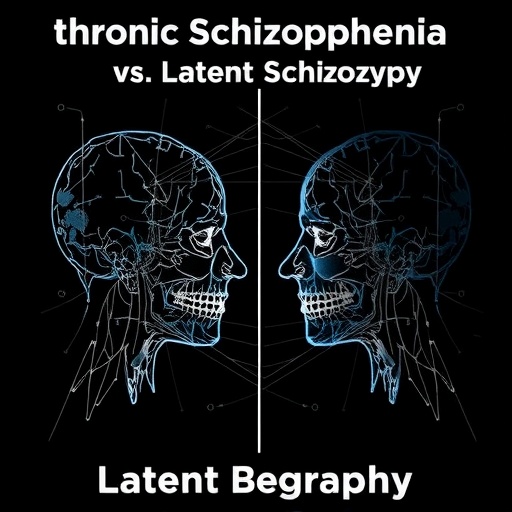In the ever-evolving landscape of psychiatric research, the application of wearable technologies has begun to shed new light on complex mental health disorders. A groundbreaking study recently published in BMC Psychiatry delves into the intricate motor activity patterns associated with schizophrenia, utilizing actigraphy to uncover distinct physiological signatures along the spectrum—from premorbid latent schizotypy to chronic schizophrenia. This research not only pioneers a novel approach to characterizing these conditions but also highlights the potential of machine learning in transforming psychiatric diagnostics.
Actigraphy, a technique traditionally employed to monitor sleep-wake cycles through non-invasive movement tracking, is now revealing hidden facets of psychiatric symptomatology. The study draws data from two distinct cohorts: patients diagnosed with chronic schizophrenia at Hauke Land University Hospital, and healthy university students from the University of Szeged who exhibit varying degrees of schizotypal traits. This dual-database approach allows for a comprehensive comparison between the extremes of the schizophrenia spectrum.
The chronic schizophrenia group reflects a population long affected by the disorder, often undergoing pharmacological treatment, which complicates the interpretation of activity patterns. In contrast, the premorbid latent schizotypy group constitutes individuals at potential risk, identified through questionnaire screening but otherwise healthy. This juxtaposition paves the way for distinguishing early markers from long-term disease manifestations, offering invaluable insights into the progression and underlying mechanisms of schizophrenia.
Sophisticated data processing techniques were employed to extract a multitude of actigraphic features from raw accelerometer readings. These features encompassed measures related to motor activity intensity, sleep quality, circadian rhythms, and daytime activity fluctuations. By decoding these parameters, researchers sought to pinpoint characteristic movement signatures that correlate with the neuropsychiatric status of each participant.
The machine learning models, trained on these rich feature sets, achieved strikingly high accuracy rates: approximately 90-95% in identifying chronic schizophrenia cases, and a somewhat lower but still notable 70-85% in recognizing premorbid schizotypal traits. These results underscore the profound differences in motor behavior between established schizophrenia and early liability phases, while illustrating the challenges inherent in detecting subtle prodromal signs.
Analytical models were not merely black boxes but were interrogated using state-of-the-art explanation tools. This transparency uncovered that sleep-related actigraphic features dominate the premorbid latent schizotypy phase, suggesting that disturbances in sleep architecture may serve as early biomarkers for schizophrenia risk. Conversely, in chronic schizophrenia, an amalgamation of sleep and daytime motor activity parameters emerged as critical, reflecting the complex symptomatology and possibly the influence of antipsychotic medication.
The study also brings attention to a persistent hurdle in schizophrenia research: the difficulty of studying patients free from pharmacological intervention. Medication-induced modulation of motor activity can obscure true disease signals, posing a significant confounder in interpreting actigraphic data. This complexity mandates cautious extrapolation and highlights the need for carefully designed longitudinal studies.
A salient implication of this work is the potential utility of actigraphy as a non-invasive, cost-effective screening tool in clinical and even community settings. By objectively quantifying movement and restlessness, clinicians might better identify individuals in the high-risk or prodromal stages of schizophrenia, facilitating earlier intervention strategies that could mitigate or delay disease onset.
The research team recommends future focused investigations within prodromal and clinical high-risk populations, aiming to enhance the predictive power and specificity of actigraphic biomarkers. Integrating these physiological data with genetic, neuroimaging, and cognitive assessments could forge a multidimensional framework for deciphering schizophrenia’s pathophysiology.
Beyond schizophrenia, this study exemplifies the transformative potential of leveraging wearable sensor technologies coupled with artificial intelligence in psychiatry. As mental health diagnoses shift increasingly toward objective metrics, the era of personalized psychiatric care moves closer to reality, promising to revolutionize treatment approaches and patient outcomes.
Moreover, the insights gained from the contrasting motor activity profiles reinforce the conceptualization of schizophrenia as a spectrum disorder, encompassing asymptomatic liability states as well as overt chronic illness. Understanding this continuum is essential for dismantling stigmas and fostering nuanced therapeutic paradigms that are tailored to each phase of the disorder.
In sum, the integration of actigraphy and machine learning has unveiled compelling new dimensions of schizophrenia research. The findings not only advance scientific knowledge but also herald practical applications that may transform early diagnosis and monitoring. This innovative methodology opens avenues for similar approaches in other psychiatric disorders, signaling a paradigm shift toward technology-driven mental health care.
The challenge moving forward lies in validating these findings across larger, more diverse cohorts and integrating them with conventional clinical practice. As the field embraces these advances, the promise of precise, automated, and real-time psychiatric assessment becomes increasingly tangible, carrying profound implications for patients and healthcare systems worldwide.
Subject of Research: Motor activity alterations in schizophrenia spectrum disorders analyzed via actigraphy and machine learning.
Article Title: The two ends of the spectrum: comparing chronic schizophrenia and premorbid latent schizotypy by actigraphy.
Article References:
László, S., Nagy, Á., Dombi, J. et al. The two ends of the spectrum: comparing chronic schizophrenia and premorbid latent schizotypy by actigraphy. BMC Psychiatry 25, 531 (2025). https://doi.org/10.1186/s12888-025-06971-5
Image Credits: AI Generated




